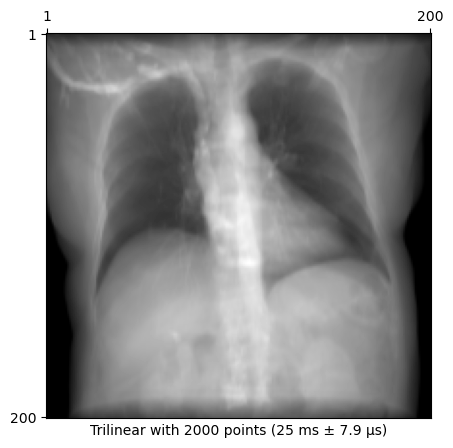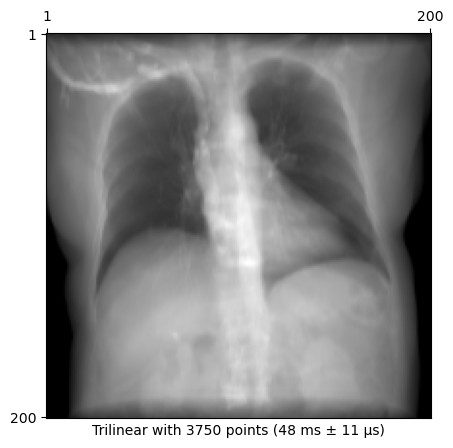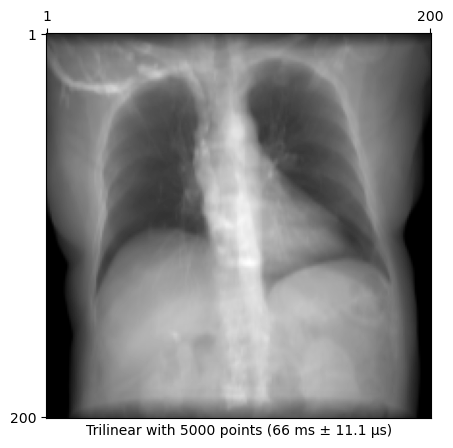import matplotlib.pyplot as plt
import torch
from IPython.core.magics.execution import _format_time
from diffdrr.data import load_example_ct
from diffdrr.drr import DRR
from diffdrr.pose import convert
from diffdrr.visualization import plot_drrTrilinear rendering
Timing demonstration for trilinear interpolation
subject = load_example_ct()
device = torch.device("cuda" if torch.cuda.is_available() else "cpu")# Set the camera pose with rotations (yaw, pitch, roll) and translations (x, y, z)
rotations = torch.tensor([[0.0, 0.0, 0.0]], device=device)
translations = torch.tensor([[0.0, 850.0, 0.0]], device=device)
pose = convert(
rotations,
translations,
parameterization="euler_angles",
convention="ZXY",
)Siddon’s method
Rendering a standard AP view with Siddon’s method takes ~25 ms. This is slower than trilinear interpolation because Siddon’s method computes the exact intersection of every cast ray with the voxels in the volume.
# Initialize the DRR module for generating synthetic X-rays
drr = DRR(
subject,
sdd=1020.0,
height=200,
delx=2.0,
).to(device)
_ = drr(pose) # Initialize drr.density
source, target = drr.detector(pose, calibration=None)
source = drr.affine_inverse(source)
target = drr.affine_inverse(target)times = %timeit -o drr.renderer(drr.density, source, target)
time = f"{_format_time(times.average, times._precision)} ± {_format_time(times.stdev, times._precision)}"
img = drr(pose)
plot_drr(img, title=f"Siddon ({time})")
plt.show()24.7 ms ± 18.2 μs per loop (mean ± std. dev. of 7 runs, 10 loops each)
Trilinear interpolation
Rendering the same view with trilinear interpolation is much faster. The main hyperparameter to control is n_points, which is the number of points to sample per ray. The rendering cost of trilinear interpolation is the same as Siddon’s method when n_points is about 2,000 points.
drr = DRR(
subject,
sdd=1020.0,
height=200,
delx=2.0,
renderer="trilinear", # Switch the rendering mode
).to(device)
source, target = drr.detector(pose, calibration=None)
_ = drr(pose) # Initialize drr.densityn_points = 25
times = %timeit -o drr.renderer(drr.density, source, target, n_points)
time = f"{_format_time(times.average, times._precision)} ± {_format_time(times.stdev, times._precision)}"
img = drr(pose, n_points=n_points)
plot_drr(img, title=f"Trilinear with {n_points} points ({time})")
plt.show()737 μs ± 2.87 μs per loop (mean ± std. dev. of 7 runs, 1,000 loops each)
n_points = 50
times = %timeit -o drr.renderer(drr.density, source, target, n_points)
time = f"{_format_time(times.average, times._precision)} ± {_format_time(times.stdev, times._precision)}"
img = drr(pose, n_points=n_points)
plot_drr(img, title=f"Trilinear with {n_points} points ({time})")
plt.show()1.03 ms ± 1.23 μs per loop (mean ± std. dev. of 7 runs, 1,000 loops each)
n_points = 100
times = %timeit -o drr.renderer(drr.density, source, target, n_points)
time = f"{_format_time(times.average, times._precision)} ± {_format_time(times.stdev, times._precision)}"
img = drr(pose, n_points=n_points)
plot_drr(img, title=f"Trilinear with {n_points} points ({time})")
plt.show()1.65 ms ± 812 ns per loop (mean ± std. dev. of 7 runs, 1,000 loops each)
n_points = 200
times = %timeit -o drr.renderer(drr.density, source, target, n_points)
time = f"{_format_time(times.average, times._precision)} ± {_format_time(times.stdev, times._precision)}"
img = drr(pose, n_points=n_points)
plot_drr(img, title=f"Trilinear with {n_points} points ({time})")
plt.show()3.52 ms ± 3.84 μs per loop (mean ± std. dev. of 7 runs, 100 loops each)
n_points = 250
times = %timeit -o drr.renderer(drr.density, source, target, n_points)
time = f"{_format_time(times.average, times._precision)} ± {_format_time(times.stdev, times._precision)}"
img = drr(pose, n_points=n_points)
plot_drr(img, title=f"Trilinear with {n_points} points ({time})")
plt.show()4.75 ms ± 5.13 μs per loop (mean ± std. dev. of 7 runs, 100 loops each)
n_points = 500
times = %timeit -o drr.renderer(drr.density, source, target, n_points)
time = f"{_format_time(times.average, times._precision)} ± {_format_time(times.stdev, times._precision)}"
img = drr(pose, n_points=n_points)
plot_drr(img, title=f"Trilinear with {n_points} points ({time})")
plt.show()7.63 ms ± 935 ns per loop (mean ± std. dev. of 7 runs, 100 loops each)
n_points = 1000
times = %timeit -o drr.renderer(drr.density, source, target, n_points)
time = f"{_format_time(times.average, times._precision)} ± {_format_time(times.stdev, times._precision)}"
img = drr(pose, n_points=n_points)
plot_drr(img, title=f"Trilinear with {n_points} points ({time})")
plt.show()13.1 ms ± 4.73 μs per loop (mean ± std. dev. of 7 runs, 100 loops each)
n_points = 2000
times = %timeit -o drr.renderer(drr.density, source, target, n_points)
time = f"{_format_time(times.average, times._precision)} ± {_format_time(times.stdev, times._precision)}"
img = drr(pose, n_points=n_points)
plot_drr(img, title=f"Trilinear with {n_points} points ({time})")
plt.show()25 ms ± 7.9 μs per loop (mean ± std. dev. of 7 runs, 10 loops each)
n_points = 2500
times = %timeit -o drr.renderer(drr.density, source, target, n_points)
time = f"{_format_time(times.average, times._precision)} ± {_format_time(times.stdev, times._precision)}"
img = drr(pose, n_points=n_points)
plot_drr(img, title=f"Trilinear with {n_points} points ({time})")
plt.show()32.3 ms ± 10.8 μs per loop (mean ± std. dev. of 7 runs, 10 loops each)
n_points = 3750
times = %timeit -o drr.renderer(drr.density, source, target, n_points)
time = f"{_format_time(times.average, times._precision)} ± {_format_time(times.stdev, times._precision)}"
img = drr(pose, n_points=n_points)
plot_drr(img, title=f"Trilinear with {n_points} points ({time})")
plt.show()48 ms ± 11 μs per loop (mean ± std. dev. of 7 runs, 10 loops each)
n_points = 5000
times = %timeit -o drr.renderer(drr.density, source, target, n_points)
time = f"{_format_time(times.average, times._precision)} ± {_format_time(times.stdev, times._precision)}"
img = drr(pose, n_points=n_points)
plot_drr(img, title=f"Trilinear with {n_points} points ({time})")
plt.show()66 ms ± 11.1 μs per loop (mean ± std. dev. of 7 runs, 10 loops each)